Abstract
Choosing an excellent method to compare the aim characteristics of a large number of cultivars simultaneously in a sufficiently comprehensive way is often an essential challenge for breeders. This article presents the results of a comprehensive assessment of the Estonian conditions of 58 strawberry (Fragaria × ananassa) cultivars of various geographical origins according to the main economically useful markers. Based on two years of data, cultivars were clustered separately for each marker using the K-means clustering method. Considering the data on the aim characteristics, including high yield, high fruit weight, high total soluble solids TSS (°Brix) content, optimal titratable acidity TA (%) content, and a high °Brix/acidity ratio, the groups of similar cultivars formed clearly. The validation of cultivars into similar groups is important for further breeding decisions. A K-means clustering method is ideal for clustering strawberry cultivars according to their characteristics.
1. Introduction
In Estonia, strawberries are a popular berry crop, which are grown on the largest area of soft-berry crops (737 ha, 2021) [1]. Due to the difference in weather conditions from year to year, the strawberry yield per hectare has fluctuated considerably over the years. For five years (2017–2021), the yield of strawberries has varied from 2.0–2.6 t/ha [1]. The self-sufficiency of locally grown fruits and berries has fallen to a shallow level, constituting only 6.8% of production [2]. One of the Estonian horticulture development program’s main goals is to increase the self-sufficiency level in soft berry crops (especially strawberries). The main focus is on creating sustainable raw material zones for strawberry cultivation for processing companies. In addition to increasing the growing area, sustainable strawberry cultivars that are resistant to local fluctuating climate conditions need to be found.
The successful solution to the problem of creating new local cultivars of berry crops is largely determined by the presence of diverse source material and the correct selection of parental pairs based on knowledge of the patterns of inheritance of the most essential traits. In this regard, special attention should be paid to the arrival of new cultivars of foreign selection with different ecological and geographical origins and the formation of characteristic gene collections. Analysing the priority areas of breeding programs in the world, it should be noted that the main efforts of breeders are currently aimed at creating high-yielding, large-fruited cultivars of an intensive type that are resistant to biotic and abiotic stresses. Particular attention is paid to the quality and appearance of fruits and their suitability for freezing and transportation [3,4,5,6,7,8,9,10]. Estonian soil and climate conditions are favourable for strawberry cultivation. Cultivars bred in countries with similar climatic conditions, such as Latvian, Lithuanian, Finnish, Polish, and Canadian cultivars, are of particular interest.
A comprehensive study of all traits in a cultivar of contexts is essential to identifying especially valuable genotypes. Total soluble solids TSS (°Brix) content, titratable acidity TA (%), and °Brix/acidity are important indicators in evaluating the taste and pleasantness of food. Considering their values helps breeders maintain the desired direction of taste in varietal breeding [11,12,13].
The work aimed to create a new collection of strawberry cultivars, select for breeding, and introduce new promising cultivars to produce. To achieve this goal, the following tasks were solved: 58 strawberry cultivars were evaluated, and their valuable economic and biological properties were analysed by the winter hardiness, yield, fruit size, and high taste characteristics of the berries. Strawberry cultivars characterised by a complex of economically valuable properties were identified. Assessment of the aim characteristics of strawberry cultivars was performed using K-means clustering.
K-means is a simple compartmental clustering algorithm to find non-overlapping clusters. The author of the idea of K-clustering is considered to be Steinhaus in 1957 [14]. The same year, Lloyd proposed the pulse coding modulation standard algorithm, which was published as late as 1982 [15]. Forgy published a similar idea in 1965, but the term “K-means” was not first used until in 1967 by MacQueen’s [16,17]. The main purpose of cluster analysis is the grouping of a set of objects in such a way that objects in the same group (cluster) are more similar to each other than in others. A positive feature of cluster analysis is its ability to compress a large amount of information, systematize it, build a scientifically based classification, and identify the internal relationship between the units of the population under study [18].
Cluster analysis makes it possible to identify and scientifically substantiate the value of each cultivar in terms of a set of indicators, taking into account their changes over the entire studied period [19,20].
2. Materials and Methods
2.1. Plant Material
The investigations were carried out in 2021–2022 at the Polli Horticultural Research Centre of the Estonian University of Life Sciences, Institute of Agricultural and Environmental Sciences (58°7′26″ N, 25°32′43″ E). There were one Belgian (‘Lovril’), eight Canadian (‘AAC Lila’, ‘Nisga’a’, ‘Annapolis’, ‘Vantage’, ‘Redcoat’, ‘Kent’, ‘Bounty’, ‘Harmonie’), one German (‘Senga Sengana’), two Estonian (‘Regatt 80’, ‘Helean’), three Finnish (‘Suvetar’, ‘Valotar’, ‘Hiku’), three French (‘Matis’, ‘Darselect’, ‘Surprise des Halles’), four British (‘Red Gauntlet’, ‘Elegance’, ‘Pegasus’, ‘Fenella’), two Italian (‘Alba’, ‘Asia’), two Latvian (‘Saulene’, ‘Junija Smaids’), four Lithuanian (‘Venta’, ‘Dange’, ‘Nida’, ‘Suitene’), eleven Dutch (‘Korona’, ‘Sonata’, ‘Induka’, ‘Sonsation’, ‘Salsa’, ‘Rumba’, ‘Allegro’, ‘Vivaldi’, ‘Polka’, ‘Lambada’, ‘Jive’), four Norwegian (‘Nobel’, ‘Jonsok’, ‘Frida’, ‘Gudlief’), five Polish (‘Panon’, ‘Filon’, ‘Dukat’, ‘Marduk’, ‘Filut’), three Russian (‘Klubnitšnaja’, ‘Festivalnaja’, ‘Lord’), one Swedish (‘Annelie’), one Scottish (‘Rhapsody’), and three United States (‘Black Swan’, ‘Earliglow’, ‘Honeoye’) cultivars in the evaluation.
2.2. Experiment Scheme
The cultivar evaluation plot was established in May 2020 by using bare-root plants. Each cultivar was planted ten plants at distances 0.3 m from each other to the plot into the soil, covered by black plastic mulch. The ground was soddy-podzolic clay loam without an irrigation system. There were no plant protection treatments applied through the cultivation season. Before planting, the soil was fertilised with NPK mineral fertiliser Cropcare 8-11-21 (Yara International, Oslo, Finland) (600 kg/ha). 5 mL of Cropcare 8-11-21 fertiliser per plant was applied by hand under black plastic mulch from the spring of the year after planting. Plant row spacing was maintained by mechanical mowing. Weeds were manually removed from around the plants once during the growing season (in the month following harvest).
2.3. Meteorological Conditions
Data on the average daily temperature and rainfall for April, May, June, and July of the testing years are shown in Figure 1. Data on the average monthly temperature for April, May, June, and July of the testing years are given in Table 1. The average monthly temperatures in April, May, June, and July were lower in 2022 than in 2021.
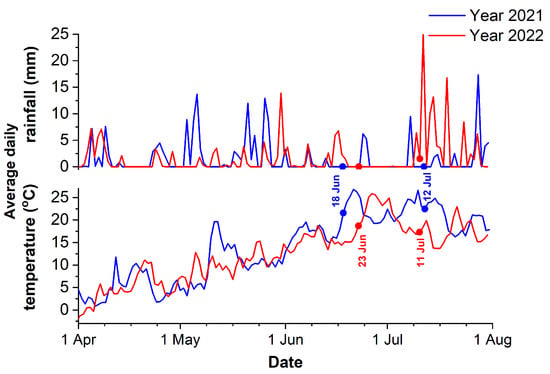
Figure 1.
Average daily temperatures (°C) and rainfall (mm) during April, May, June and July in testing years (2021–2022) in Polli.

Table 1.
Average monthly temperatures (°C) during April, May, June and July in test years (2021–2022) in Polli.
2.4. Experimental Methods
Fruit ripening began in 2021 on June 18 and ended on July 12, and in 2022, it began on June 23 and ended on July 11. In the test period, the following characteristics of strawberry cultivars were registered: the start of flowering (50% of plants with flowers), fruit ripening (>20 g/plant), total yield (g/plant), berry weight (calculated by the average weight of 20 berries weight (g) winter hardiness (scores 1–9: 1—plants destroyed, 9—no damage)). The fresh strawberry samples’ (100–120 g) calyxes were removed. Strawberry samples were homogenised for 3 min by operating a hand blender (Philips Viva Collection ProMix), and the homogenate was used for measuring TSS (°Brix) and acidity TA (%). The measurement of total soluble solids TSS (°Brix) and titratable acidity TA (%) was performed with a Pocket Brix acidity meter (Multi Fruits) PAL-BXIACID F5 (Atago, Saitama Japan). A dilution ratio of 1:50 in distilled water was used to measure acidity. The statistical processing of the research results was carried out by multivariate analysis using K-mean cluster analysis utilising the program OriginPro 2020b.
3. Results
3.1. Winter Hardiness
The winter hardiness of the plants for all strawberry varieties after the winter-spring period of 2021–2022 was evaluated with 9 points. There was no visible damage to the ground part of the plant.
3.2. Productivity
The primary indicator characterising the economic value of the cultivar is the yield. As a result of the research, it turned out that the studied cultivars differ significantly from each other in terms of this indicator. Differences in yield were observed between cultivars and within years of study of the same cultivar. The observed differences were due to the cultivar genotype, weather conditions, and the age of the fruiting plantation. The cultivars were studied during two years of fruiting. As a result of the statistical processing of the data using the cluster analysis method, three groups of varieties were identified, including high-yielding, yielding, and medium-yielding cultivars, as shown in Figure 2. In the second year of fruiting, most of the studied cultivars observed a sharp decrease in yield. A significant impact on the decline in yield was exerted by an increased temperature and a lack of rainfall in July-August 2021, as shown in Figure 1, which negatively affected the laying and formation of flower buds for the following year’s harvest. The first cluster of cultivars with an average annual yield of 424.1–624.1 g/plant were cultivars of Russian, European, and Canadian selection. The second cluster, the largest group with yearly yields of 314.4–435.0 g/plant, included mainly cultivars of European and Canadian selection. The third cluster of cultivars, whose average yield was 210.8–289.9 g/plant, is represented by cultivars of European, United States, and Canadian selection. Based on the results obtained, high-yielding cultivars are recommended for use in breeding for productivity: ‘Alba’, ‘Bounty’, ‘Frida’, ‘Hiku’, ‘Junija Smaids’, ‘Klubnitšnaja’, ‘Lord’, ‘Marduk’, ‘Saulene’.
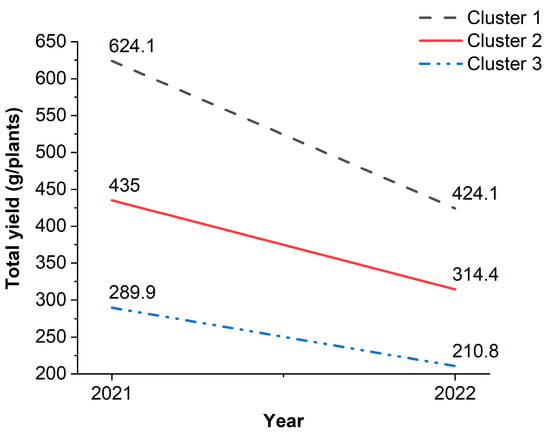
Figure 2.
Grouping cultivars of strawberry by yield by the K-mean cluster analysis.
Cluster 1 (9): ‘Alba’, ‘Bounty’, ‘Frida’, ‘Hiku’, ‘Junija Smaids’, ‘Klubnitšnaja’, ‘Lord’, ‘Marduk’, ‘Saulene’.
Cluster 2 (28): ‘AAC Lila’, ‘Asia’, ‘Darselect’, ‘Dukat,’’Elegance’, ‘Festivalnaja’, ‘Filon’, ‘Gudlief’, ‘Harmonie’, ‘Induka’, ‘Jonsok’, ‘Kent’, ‘Korona’, ‘Lovril’, ‘Nisga’a’, ‘Nobel’, ‘Panon’, ‘Redcoat’, ‘Regatt 80’, ‘Rhapsody’, ‘Salsa’, ‘Senga Sengana’, ‘Sonata’, ‘Sonsation’, ‘Suitene’, ‘Surprise des Halles’, ‘Suvetar’, ‘Venta’.
Cluster 3 (21): ‘Allegro’, ‘Annapolis’, ‘Annelie’, ‘Black Swan’, ‘Dange’, ‘Earliglow’, ‘Fenella’, ‘Filut’, ‘Helean’, ‘Honeoye’, ‘Jive’, ‘Lambada’, ‘Matis’, ‘Nida’, ‘Pegasus’, ‘Polka’, ‘Red Gauntlet’, ‘Rumba’, ‘Valotar’, ‘Vantage’, ‘Vivaldi’.
3.3. Berry’s Average Weight
An essential structural element of productivity and one of the indicators of the quality of berries is the average weight. The studied cultivars of strawberries differed significantly among themselves in fruit weight, and differences in this indicator were also found in the same varieties in different years.
The division of varieties according to average weight was carried out by cluster analysis. The varieties were divided into three clusters: high average weight, cultivars with a medium average weight, and low average weight, as shown in Figure 3.
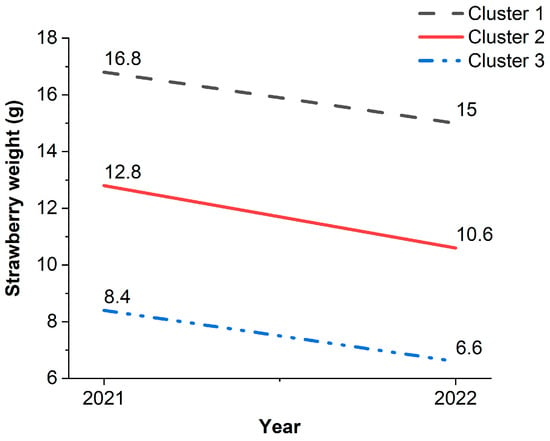
Figure 3.
Grouping cultivars of strawberries by average berry weight by the K-mean cluster analysis.
Cluster 1 (23): ‘Alba’, ‘Allegro’, ‘Asia’, ‘Black Swan’, ‘Elegance’, ‘Filon’, ‘Filut’, ‘Frida’, ‘Harmonie’, ‘Jive’, ‘Kent’, ‘Lambada’, ‘Lovril’, ‘Marduk’, ‘Matis’, ‘Nisga’a’, ‘Panon’, ‘Pegasus’, ‘Rumba’, ‘Salsa’, ‘Saulene’, ‘Sonata’, ‘Suitene’.
Cluster 2 (26): ‘AAC Lila’, ‘Annapolis’, ‘Dange’, ‘Darselect’, ‘Dukat’, ‘Fenella’, ‘Festivalnaja’, ‘Gudlief’, ‘Hiku’, ‘Honeoye’, ‘Induka’, ‘Jonsok’, ‘Junija Smaids’, ‘Korona’, ‘Lord’, ‘Nida’, ‘Polka’, ‘Red Gauntlet’, ‘Redcoat’, ‘Regatt 80’, ‘Rhapsody’, ‘Sonsation’, ‘Surprise des Halles’, ‘Suvetar’, ‘Venta’, ‘Vivaldi’.
Cluster 3 (9): ‘Annelie’, ‘Bounty’, ‘Earliglow’, ‘Helean’, ‘Klubnitšnaja’, ‘Nobel’, ‘Senga Sengana’, ‘Valotar’, ‘Vantage’.
All the studied cultivars were distinguished by a decrease in the average berry weight in 2022. This is due to low rainfalls, dry conditions, and a lack of moisture in the upper layers of the soil during the fruiting period in 2022. The highest weights (the average weight of a berry in the group is 15–16.8 g) were mainly from those cultivars of European and Canadian selection. Thus, strawberry varieties from the first cluster are of further interest for breeding as a source of the highest average weight of a berry.
3.4. Total Soluble Solids TSS
Sweetness is one of the most critical quality attributes of strawberries. A linear relationship has been found between strawberry total soluble solids TSS (°Brix) content and consumer value. The higher the TSS content, the higher the rating given to the strawberry cultivar. A strawberry cultivar containing at least 8% TSS can already be considered almost ideal [21]. During the test period under Estonian weather conditions, the strawberry varieties in 2021 and 2022 accumulated 7.1–12% TSS in the berries. In 2022, when rainfall was minimal during the berry ripening period, all studied strawberry cultivars were characterised by a high TSS content (over 8%). The maximum TSS content (8.9–11.8%) in the cluster formed in the comparison of two years was noted in the United States cultivars ‘Annapolis’, ‘Black Swan’, ‘Earliglow’, in the Canadian cultivars ‘AAC Lila’, ‘Annapolis’, ‘Vantage and in the European varieties ‘Nida’, ‘Dange’, ‘Lambada’, ‘Frida’, ‘Gudlief’, ‘Rumba’ and local Estonian varieties Regatt 80’, ‘Helean’ Figure 4.
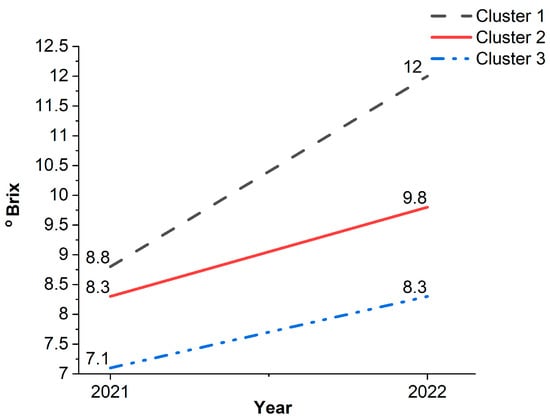
Figure 4.
Grouping of strawberry cultivars by total soluble solids TSS (°Brix) content by the K-mean cluster analysis.
Cluster 1 (14): ‘AAC Lila’, ‘Annapolis’, ‘Black Swan’, ‘Dange, Earliglow’, ‘Frida’, ‘Helean’, ‘Honeoye’, ‘Korona’, ‘Lambada’, ‘Nida’, ‘Regatt 80’, ‘Rumba’, ‘Vantage’.
Cluster 2 (22): ‘Annelie’, ‘Bounty’, ‘Darselect’, ‘Fenella’, ‘Festivalnaja’, ‘Gudlief’, ‘Jive’, ‘Kent’, ‘Klubnitšnaja’, ‘Matis’, ‘Nisga’a’, ‘Nobel’, ‘Pegasus’, ‘Polka’, ‘Redcoat’, ‘Saulene’, ‘Sonata’, ‘Sonsation’, ‘Surprise des Halles’, ‘Suvetar’, ‘Valotar’, ‘Vivaldi’.
Cluster 3 (22): ‘Alba’, ‘Allegro’, ‘Asia’, ‘Dukat’, ‘Elegance’, ‘Filon’, ‘Filut’, ‘Harmonie’, ‘Hiku’, ‘Induka’, ‘Jonsok’, ‘Junija Smaids’, ‘Lord’, ‘Lovril’, ‘Marduk’, ‘Panon’, ‘Red Gauntlet’, ‘Rhapsody’, ‘Salsa’, ‘Senga Sengana’, ‘Suitene’, ‘Venta’.
Thus, the results of the research made it possible to identify varieties of strawberries that are of interest for further breeding as a source of high total soluble solids TSS (°Brix) content (8.8–12%): ‘AAC Lila’, ‘Annapolis’, ‘Black Swan’, ‘Dange’, ‘Earliglow’, ‘Frida’, ‘Helean’, ‘Honeoye’, ‘Korona’, ‘Lambada’, ‘Nida’, ‘Regatt 80’, ‘Rumba’, ‘Vantage’.
3.5. Titratable Acidity TA (%)
Organic acids in the strawberries’ berries are free and bound. They contain citric, malic, benzoic, oxalic, tartaric, salicylic, and succinic acids [22,23,24]. Strawberry varieties with a low content of titratable acids have a mild taste and have been observed to lose colour when frozen [25]. The optimal acidity % of the strawberries (1–1.1%) was noted on the cultivars of the first cluster: ‘Festivalnaja’, ‘Honeoye’, ‘Earliglow’, ‘Surprise des Halles’, ‘Dange’, ‘Regatt 80’, ‘Redcoat’, as shown in Figure 5.
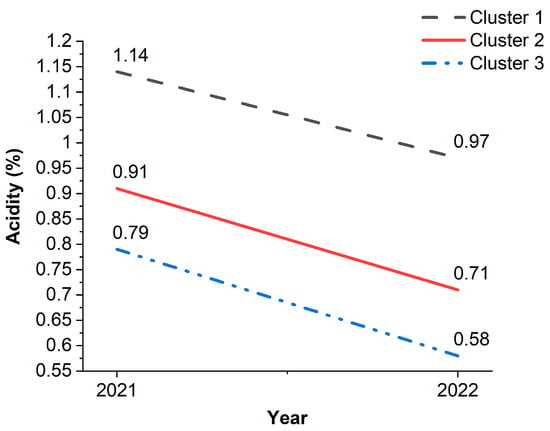
Figure 5.
Grouping varieties of strawberries according to acidity % by the K-mean cluster analysis.
Cluster 1 (7): ‘Dange, Earliglow’, ‘Festivalnaja’, ‘Honeoye, Redcoat’, ‘Regatt 80’, ‘Surprise des Halles’.
Cluster 2 (30): ‘AAC Lila’, ‘Alba’, ‘Allegro’, ‘Annapolis’, ‘Black Swan’, ‘Dukat’, ‘Gudlief’, ‘Harmonie’, ‘Helean’, ‘Induka’, ‘Jive’, ‘Jonsok’, ‘Junija’, ‘Smaids’, ‘Kent’, ‘Klubnitšnaja’, ‘Lambada’, ‘Nida’, ‘Panon’, ‘Pegasus’, ‘Polka’, ‘Red Gauntlet’, ‘Rhapsody’, ‘Rumba’, ‘Senga Sengana’, ‘Sonata’, ‘Suitene’, ‘Valotar’, ‘Vantage’, ‘Venta’, ‘Vivaldi’.
Cluster 3 (21): ‘Annelie’, ‘Asia’, ‘Bounty’, ‘Darselect’, ‘Elegance’, ‘Fenella’, ‘Filon’, ‘Filut’, ‘Frida’, ‘Hiku’, ‘Korona’, ‘Lord’, ‘Lovril’, ‘Marduk’, ‘Matis’, ‘Nisga’a’, ‘Nobel’, ‘Salsa’, ‘Saulene’, ‘Sonsation’, ‘Suvetar’.
3.6. The Taste
Total soluble solids TSS and organic acids are the typical soluble constituents of strawberry fruit. They have an essential influence on taste and shelf life, and they are reliable indicators of acceptability by consumers. Shifts in total soluble solids TSS and organic acid composition and concentration are also reflected in the quality of fresh fruits and berries. As a rule, berries with a higher TSS/TA% index (the ratio °Brix/acidity) have the best flavour harmony [26,27,28]. Cluster analysis divided the cultivars evenly into three groups according to the ratio of °Brix/acidity, as shown in Figure 6.
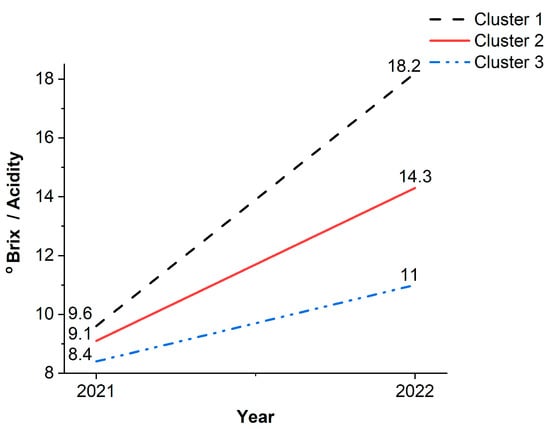
Figure 6.
Grouping cultivars of strawberry according to the ratio of °Brix/Acidity by the K-mean cluster analysis.
Cluster 1 (19): ‘AAC Lila’, ‘Lambada’, ‘Vantage’, ‘Annapolis’, ‘Annelie’, ‘Suvetar’, ‘Black Swan’, ‘Frida’, ‘Filut’, ‘Darselect’, ‘Rumba’, ‘Fenella’, ‘Helean’, ‘Matis’, ‘Korona’, ‘Filon’, ‘Nida’, ‘Lovril’, ‘Gudlief’.
Cluster 2 (18): ‘Honeoye’, ‘Harmonie’, ‘Pegasus’, ‘Nobel’, ‘Earliglow’, ‘Nisga’a’, ‘Salsa’, ‘Saulene’, ‘Senga Sengana’, ‘Sonata’, ‘Sonsation’, ‘Dange’, ‘Bounty’, ‘Asia’, ‘Valotar’, ‘Junija Smaids’, ‘Kent’, ‘Klubnitšnaja’.
Cluster 3 (21): ‘Redcoat’, ‘Rhapsody’, ‘Suitene’, ‘Panon’, ‘Hiku’, ‘Elegance’, ‘Jonsok’, ‘Surprise des Halles’, ‘Lord’, ‘Alba’, ‘Festivalnaja’, ‘Vivaldi’, ‘Venta’, ‘Allegro’, ‘Marduk’, ‘Jive’, ‘Induka’, ‘Polka’, ‘Red Gauntlet’, ‘Dukat’, ‘Regatt 80’.
The weather with minimal rainfall in 2022 contributed to the evolution of the rich taste of the studied strawberry cultivars (°Brix/acidity: 18.2). Mainly European and Canadian selection cultivars with high taste characteristics (°Brix/acidity: 9.6–18.2) were grouped in the first cluster. Thus, as a result of the research, sources of high taste qualities were identified cultivars: ‘Nobel’, ‘Kent’, ‘Frida’, ‘Lovril’, ‘Rumba’, ‘Salsa’, ‘Saulene’, ‘Darselect’, ‘Dange’, ‘Sonsation’, ‘Bounty’, ‘Pegasus’, ‘Suvetar’, ‘Nisga’a’, ‘Vantage’, ‘Lambada’, ‘Klubnitšnaja’.
4. Discussion
As a result of the research on the collection of strawberry varieties of different geographical origins, it was successfully found to identify cultivars that are sources of economically valuable characteristics for further breeding:
High-yielding cultivars: ‘Alba’, ‘Bounty’, ‘Frida’, ‘Hiku’, ‘Junija Smaids’, ‘Klubnitšnaja’, ‘Lord’, ‘Marduk’, ‘Saulene’.
High average weight cultivars: ‘Alba’, ‘Allegro’, ‘Asia’, ‘Black Swan’, ‘Elegance’, ‘Filon’, ‘Filut’, ‘Frida’, ‘Harmonie’, ‘Jive’, ‘Kent’, ‘Lambada’, ‘Lovril’, ‘Marduk’, ‘Matis’, ‘Nisga’a’, ‘Panon’, ‘Pegasus’, ‘Rumba’, ‘Salsa’, ‘Saulene’, ‘Sonata’, ‘Suitene’.
High total soluble solids TSS contant cultivars: ‘AAC Lila’, ‘Annapolis’, ‘Black Swan’, ‘Dange, Earliglow’, ‘Frida’, ‘Helean’, ‘Honeoye’, ‘Korona’, ‘Lambada’, ‘Nida’, ‘Regatt 80’, ‘Rumba’, ‘Vantage’.
Optimal titratable acidity TA (%) cultivars: ‘Dange, Earliglow’, ‘Festivalnaja’, ‘Honeoye, Redcoat’, ‘Regatt 80’, ‘Surprise des Halles’.
High taste qualities cultivars: ‘AAC Lila’, ‘Lambada’, ‘Vantage’, ‘Annapolis’, ‘Annelie’, ‘Suvetar’, ‘Black Swan’, ‘Frida’, ‘Filut’, ‘Darselect’, ‘Rumba’, ‘Fenella’, ‘Helean’, ‘Matis’, ‘Korona’, ‘Filon’, ‘Nida’, ‘Lovril’, ‘Gudlief’.
In the evaluation of the aim characteristics, including yielding, the average weight and, the taste qualities of strawberry cultivars, it turned out that only the Norwegian cultivar ‘Frida’ belonged to the first cluster in all these analysed parameters. Remaining in the second cluster with one characteristic, cultivars ‘Filon’ (Poland), ‘Saulene’ (Latvia), and ‘Lovril’ (Belgium) also showed very high results.
The results that the strawberry variety ‘Frida’ have high yielding, high average weight, and very good taste qualities are well supported by scientific works published in the last ten years [29,30,31].
5. Conclusions
Successfully grouping and comparing cultivar characteristics across large quantities of varieties is not an easy challenge. Assessment of the aim characteristics of 58 strawberry (Fragaria × ananassa) cultivars in Estonia by using the K-means cluster method was a great success. K-means clustering is a simple and powerful method for solving such tasks. As a result of the work, we were able to group 58 strawberry varieties into clusters based on two years of data, which is an excellent help in planning breeding, creating cultivar collections, and establishing production plantations.
Author Contributions
Conceptualization, N.K. and A.K.; methodology, N.K., A.-V.L. and A.K.; software, N.K. and P.L.; validation, N.K., P.L., A.-V.L. and A.K.; formal analysis, N.K. and P.L.; investigation, N.K., P.L., A.-V.L. and A.K.; resources, A.K. and A.-V.L.; data curation, A.K. and A.-V.L.; writing—original draft preparation, N.K. and P.L.; writing—review and editing, N.K., P.L., A.-V.L. and A.K.; visualisation, N.K. and P.L.; supervision, A.K. and A.-V.L.; project administration, A.K.; funding acquisition, A.K. All authors have read and agreed to the published version of the manuscript.
Funding
This research was funded by the Estonian Ministry of Rural Affairs for the programme “Collection, Conservation and Use of Genetic Resources for Agricultural Crops 2021–2027”.
Institutional Review Board Statement
Not applicable.
Informed Consent Statement
Not applicable.
Data Availability Statement
Not applicable.
Acknowledgments
The authors want to thank the Estonian Ministry of Rural Affairs.
Conflicts of Interest
The authors declare no conflict of interest.
References
- Statistics Database. PM0281: Põllumajandusmaa ja Kultuurid. Available online: https://andmed.stat.ee/et/stat/majandus__pellumajandus__pellumajandussaadustetootmine__taimekasvatussaadustetootmine/PM0281/table/tableViewLayout2 (accessed on 13 December 2022).
- Paju, E. Põllumajanduse, Kalanduse, Maaelu ja Toiduainetööstuse Ülevaade. Ministry of Rural Affairs: Tallinn, Estonia, 2021. Available online: https://www.agri.ee/media/1355/download (accessed on 13 December 2022).
- University of Florida, Institute of Food and Agricultural Sciences (UF/IFAS). Strawberry—Plant Breeding Program. Available online: https://programs.ifas.ufl.edu/plant-breeding/strawberry/ (accessed on 13 December 2022).
- Mezzetti, B.; Giampieri, F.; Zhang, Y.T.; Zhong, C.F. Status of Strawberry Breeding Programs and Cultivation Systems in Europe and the Rest of the World. J. Berry Res. 2018, 8, 205–221. [Google Scholar] [CrossRef]
- Samtani, J.B.; Rom, C.R.; Friedrich, H.; Fennimore, S.A.; Finn, C.E.; Petran, A.; Wallace, R.W.; Pritts, M.P.; Fernandez, G.; Chase, C.A.; et al. The Status and Future of the Strawberry Industry in the United States. Horttechnology 2019, 29, 11–24. [Google Scholar] [CrossRef]
- Klakotskaya, N.V.; Puhachov, R.M. Current Strawberry Research in Belarus, Review. In Proceedings of the IX International Strawberry Symposium, Rimini, Italy, 1–5 May 2021; pp. 407–412. [Google Scholar] [CrossRef]
- Whitehouse, A.B.; Johnson, A.W.; Hopson, K.J.; Passey, A.J.; Sargent, D. “Malling™ Allure’and’Malling™ Champion”: Two New Strawberry Cultivars from NIAB EMR, United Kingdom. In Proceedings of the IX International Strawberry Symposium, Rimini, Italy, 1–5 May 2021; Available online: https://www.ishs.org/ishs-article/1309_24 (accessed on 13 December 2022).
- Balducci, F.; Marcellini, M.; Schrey, S.; Linnemannstöns, L.; Capocasa, F.; Mezzetti, B.; Mazzoni, L. “Francesca”,’Lauretta’,’Silvia’and’Dina’: Four New Strawberry Cultivars for Northern and Southern European Cultivation Conditions from the Marche Polytechnic University Breeding Programme. In Proceedings of the IX International Strawberry Symposium, Rimini, Italy, 1–5 May 2021; pp. 205–208. [Google Scholar] [CrossRef]
- Turci, P.; Baruzzi, G.; Ballini, L.; Birolli, M.; Capriolo, G.; Carullo, A.; Faedi, G.; Funaro, M.; Gimelli, N.; Magnani, S. Updates on Italian Strawberry Breeding Programs Coordinated by CREA. In Proceedings of the IX International Strawberry Symposium, Rimini, Italy, 1–5 May 2021; pp. 1069–1075. [Google Scholar] [CrossRef]
- Whitehouse, A.B.; Johnson, A.W.; Cockerton, H.M.; Nellist, C.F.; Li, B.; Wilson, F.; Hopson, K.J.; Passey, A.J.; Harrison, R.J. Recent Progress in Strawberry Breeding and Genetics at NIAB EMR, East Malling, UK. In Proceedings of the IX International Strawberry Symposium, Rimini, Italy, 1–5 May 2021; pp. 169–174. [Google Scholar] [CrossRef]
- Ulrich, D.; Olbricht, K. Searching for Chemical and Sensory Parameters for Flavor Enhancement in Strawberry Breeding. Acta Hortic. 2017, 1156, 653–659. [Google Scholar] [CrossRef]
- Kikas, A.; Vinogradov, M.; Arus, L.; Laurson, P.; Libek, A.V. Evaluation of Strawberry (Fragaria × ananassa) Cultivars in Estonia. In Proceedings of the IX International Strawberry Symposium, Rimini, Italy, 1–5 May 2021; Volume 1309, pp. 235–240. [Google Scholar] [CrossRef]
- Kikas, A.; Libek, A.; Kaldmäe, H.; Hanni, L. Evaluation of Strawberry Cultivars in Estonia. Sodinink Darzinink 2007, 26, 131–137. [Google Scholar]
- Steinhaus, H. Sur la Division des Corps Matériels en Parties. Bull. Acad. Pol. Sci. 1956, 4, 801–804. [Google Scholar]
- Lloyd, S.P. Least Squares Quantization in PCM. IEEE Trans. Inf. Theory 1982, 28, 129–137. [Google Scholar] [CrossRef]
- Forgey, E. Cluster Analysis of Multivariate Data: Efficiency vs. Interpretability of Classification. Biometrics 1965, 21, 768–769. [Google Scholar]
- Zeebaree, D.Q.; Haron, H.; Mohsin Abdulazeez, A.; Zeebaree, S.R.M. Combination of K-Means Clustering with Genetic Algorithm: A Review. Int. J. Appl. Eng. Res. 2017, 12, 14238–14245. [Google Scholar]
- Backhaus, K.; Erichson, B.; Gensler, S.; Weiber, R.; Weiber, T. Cluster Analysis. In Multivariate Analysis; Springer: Wiesbaden, Germany, 2021; pp. 451–530. [Google Scholar]
- Rajan, S.; Yadava, L.P.; Kumar, R.; Saxena, S.K. Genetic Divergence in Mango Varieties and Possible Use in Breeding. Indian J. Hortic. 2009, 66, 7–12. [Google Scholar]
- Klakotskaya, N.V.; Radkevich, D.B. Formation of Target Feature Collections in Priority Areas of Strawberry Breeding. Frui Growing 2016, 28, 154–161. [Google Scholar]
- Azodanlou, R.; Darbellay, C.; Luisier, J.L.; Villettaz, J.C.; Amado, R. Quality Assessment of Strawberries (Fragaria Species). J. Agric. Food Chem. 2003, 51, 715–721. [Google Scholar] [CrossRef]
- Enomoto, H.; Sato, K.; Miyamoto, K.; Ohtsuka, A.; Yamane, H. Distribution Analysis of Anthocyanins, Sugars, and Organic Acids in Strawberry Fruits Using Matrix-Assisted Laser Desorption/Ionization-Imaging Mass Spectrometry. J. Agric. Food Chem. 2018, 66, 4958–4965. [Google Scholar] [CrossRef]
- Urün, I.; Attar, S.H.; Sönmez, D.A.; Gündeşli, M.A.; Ercişli, S.; Kafkas, N.E.; Bandić, L.M.; Duralija, B. Comparison of Polyphenol, Sugar, Organic Acid, Volatile Compounds, and Antioxidant Capacity of Commercially Grown Strawberry Cultivars in Turkey. Plants 2021, 10, 1654. [Google Scholar] [CrossRef]
- Kallio, H.; Hakala, M.; Pelkkikangas, A.-M.; Lapveteläinen, A.; Kallio, H.; Hakala, M.; Pelkkikangas, A.-M.; Lapveteläinen, A. Sugars and Acids of Strawberry Varieties. Eur. Food Res. Technol. 2000, 212, 81–85. [Google Scholar] [CrossRef]
- Wrolstad, R.E.; Putnam, T.P.; Varseveld, G.W. Color Quality of Frozen Strawberries: Effect of Anthocyanin, PH, Total Acidity and Ascorbic Acid Variability. J. Food Sci. 1970, 35, 448–452. [Google Scholar] [CrossRef]
- Kafkas, E.; Koşar, M.; Türemiş, N.; Başer, K.H.C. Analysis of Sugars, Organic Acids and Vitamin C Contents of Blackberry Genotypes from Turkey. Food Chem. 2006, 97, 732–736. [Google Scholar] [CrossRef]
- Tosun, M.; Ercisli, S.; Karlidag, H.; Sengul, M. Characterization of Red Raspberry (Rubus idaeus L.) Genotypes for Their Physicochemical Properties. J. Food Sci. 2009, 74, C575–C579. [Google Scholar] [CrossRef]
- Akagić, A.; Oras, A.V.; Žuljević, S.O.; Spaho, N.; Drkenda, P.; Bijedić, A.; Memić, S.; Hudina, M. Geographic Variability of Sugars and Organic Acids in Selected Wild Fruit Species. Foods 2020, 9, 462. [Google Scholar] [CrossRef]
- Opstad, N.; Sønsteby, A.; Myrheim, U.; Heide, O.M. Seasonal Timing of Floral Initiation in Strawberry: Effects of Cultivar and Geographic Location. Sci. Hortic. 2011, 129, 127–134. [Google Scholar] [CrossRef]
- Krüger, E.; Woznicki, T.L.; Heide, O.M.; Kusnierek, K.; Rivero, R.; Masny, A.; Sowik, I.; Brauksiepe, B.; Eimert, K.; Mott, D.; et al. Flowering Phenology of Six Seasonal-Flowering Strawberry Cultivars in a Coordinated European Study. Horticulturae 2022, 8, 933. [Google Scholar] [CrossRef]
- Sønsteby, A.; Heide, O.M. Temperature Responses, Flowering and Fruit Yield of the June-Bearing Strawberry Cultivars Florence, Frida and Korona. Sci. Hortic. 2008, 119, 49–54. [Google Scholar] [CrossRef]
Disclaimer/Publisher’s Note: The statements, opinions and data contained in all publications are solely those of the individual author(s) and contributor(s) and not of MDPI and/or the editor(s). MDPI and/or the editor(s) disclaim responsibility for any injury to people or property resulting from any ideas, methods, instructions or products referred to in the content. |
© 2023 by the authors. Licensee MDPI, Basel, Switzerland. This article is an open access article distributed under the terms and conditions of the Creative Commons Attribution (CC BY) license (https://creativecommons.org/licenses/by/4.0/).